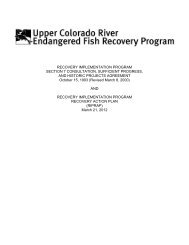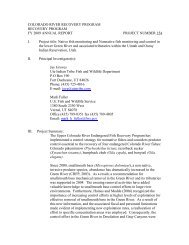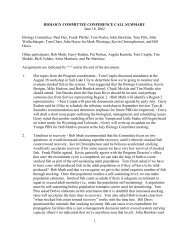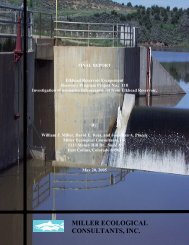K. R. Bestgen, K. A. Zelasko, and G. C. White. Monitoring ...
K. R. Bestgen, K. A. Zelasko, and G. C. White. Monitoring ...
K. R. Bestgen, K. A. Zelasko, and G. C. White. Monitoring ...
Create successful ePaper yourself
Turn your PDF publications into a flip-book with our unique Google optimized e-Paper software.
a side channel, <strong>and</strong> that a side channel is a main feature of the middle Green River spawning<br />
area, Razorback Bar. Such areas should be considered for monitoring with passive PIT tag<br />
detector antennae, which may substantially boost numbers of recaptured fish in each area.<br />
The importance of tributary habitat in downstream <strong>and</strong> upstream reaches (nearly 35 <strong>and</strong><br />
40% use, respectively) of the lower Green River is notable, because those habitat types are<br />
mostly unavailable in seasons other than spring when those places are inundated with snowmelt<br />
runoff flows. Investigators should target such habitats to increase capture rates of razorback<br />
suckers, especially in the upper reach of the lower Green River where more fish occur, both with<br />
active sampling gear, <strong>and</strong> perhaps, with passive gear such as hoop nets, which may be deployed<br />
<strong>and</strong> checked less frequently. Hoop nets deployed in low-velocity channel margin areas were an<br />
effective gear to sample razorback suckers in the middle Green River from 1996–1999, <strong>and</strong><br />
captures made with those gears greatly supplemented fish captures compared to those made with<br />
just electrofishing, which occurred mainly over Razorback Bar (<strong>Bestgen</strong> et al. 2002). Such<br />
locations should also be evaluated for use of PIT tag detector antennae. In spite of their high<br />
initial cost, high potential detection rates of fish in concentration areas such as flooded tributary<br />
mouths may warrant their use, <strong>and</strong> in the longer-term, be cost effective compared to exclusive<br />
use of active sampling gear. Flooded tributaries are also typically low-velocity environments,<br />
which may be advantageous when deploying detection gear compared to the swifter flowing<br />
main or side channels.<br />
In the Desolation-Gray Canyon reach, razorback sucker capture numbers were relatively<br />
low <strong>and</strong> were more uniformly distributed. The most upstream 10-mile section, which was just<br />
downstream of the S<strong>and</strong> Wash boat ramp <strong>and</strong> the main access for stocking hatchery fish, was<br />
where the most fish were captured, but lack of concentration areas precluded more detailed<br />
mapping of such. Fish macrohabitat use in that area was dominated by main channel captures,<br />
with a smaller number of backwater <strong>and</strong> very few tributary (mainly Price River mouth) captures<br />
(Figure 7). That area is sampled mostly earlier in the year during Colorado pikeminnow<br />
abundance estimation (Table 5), so the importance of tributary habitat may be lower in that lower<br />
flow period.<br />
In the middle Green River, razorback sucker captures were also relatively uniform <strong>and</strong><br />
low relative to the lower Green River. Also similar to the Desolation-Gray Canyon reach, most<br />
fish were captured in the two most upstream reaches <strong>and</strong> just downstream of the Split Mountain<br />
Boat Ramp where most fish were stocked. We plotted the fine-scale distribution of razorback<br />
30










